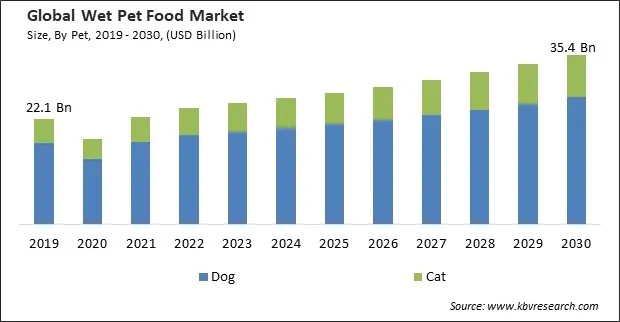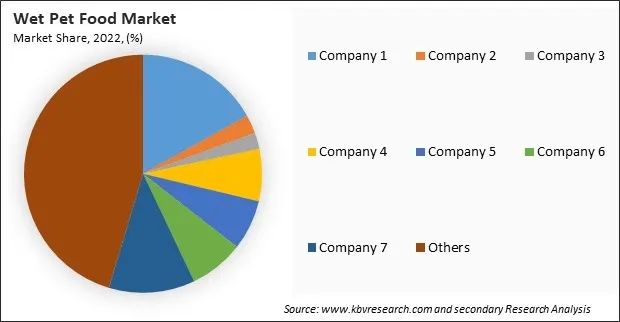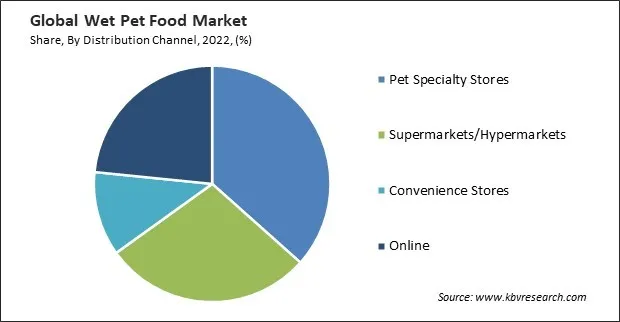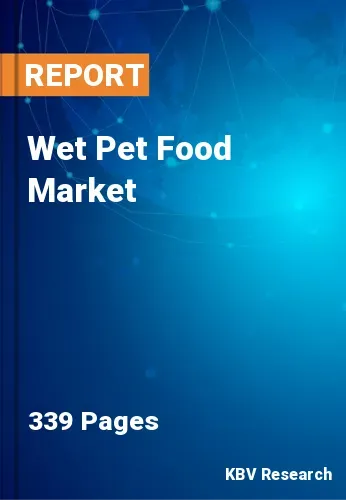The Global Wet Pet Food Market size is expected to reach $35.4 billion by 2030, rising at a market growth of 4.9% CAGR during the forecast period. In the year 2022, the market attained a volume of 3467.8 Kilo Tonnes experiencing a growth of 2.0% (2019-2022).
E-commerce platforms have additionally facilitated targeted marketing techniques, enabling wet pet food brands to adapt their messaging to a range of pet owner preferences and demographics. Consequently, the online segment would generate approximately 23.6% share of the market by 2030. Based on prior purchases or browsing behavior, tailored suggestions and advertisements further improve the customer experience, boosting sales and revenue. Some of the factors affecting the market are the rising need for premium and specialized formulations, increase in pet ownership and humanization, and high cost of wet food production.

Premium formulations often prioritize the use of high-quality ingredients, such as real meat, poultry, or fish as primary protein sources. This focus on quality enhances the nutritional content of wet pet food, providing pets with a well-balanced diet that supports their health and well-being. Pet owners are increasingly inclined to choose premium wet pet food, recognizing its superior nutritional value. Moreover, the rise in pet ownership has been a fundamental driver of market expansion. As more households’ welcome pets into their lives, the overall demand for pet food, particularly wet pet food, has surged. Pet ownership, once considered a lifestyle choice, has transformed into a cultural norm, spurring consistent growth in the market. With a larger pet-owning population, the market has diversified to meet the varied needs of pets and their owners. In parallel, the humanization of pets has significantly influenced consumer behavior. The surge in pet ownership, the humanization of pets, and the influence of veterinary recommendations have propelled the demand for high-quality and specialized pet food products, particularly wet pet food.
However, the elevated costs associated with sourcing high-quality ingredients, processing, and specialized packaging contribute to higher price points for these products. This can deter price-sensitive consumers who may opt for more budget-friendly pet food alternatives, such as dry kibble. High production costs can also limit the profitability of manufacturers. The financial burden of producing wet pet food, coupled with the competitive nature of the pet food industry, may lead to reduced profit margins. Manufacturers may face challenges in offering competitive pricing or investing in marketing and product development. Therefore, these factors can hamper the growth of the market.

The leading players in the market are competing with diverse innovative offerings to remain competitive in the market. The above illustration shows the percentage of revenue shared by some of the leading companies in the market. The leading players of the market are adopting various strategies in order to cater demand coming from the different industries. The key developmental strategies in the market are Acquisitions, and Partnerships & Collaborations.
By distribution channel, the market is classified into pet specialty stores, supermarkets/hypermarkets, convenience stores, and online. In 2022, the pet specialty stores recorded the maximum revenue share in the market. It is anticipated that the appealing shelf arrangements in specialty pet food retail stores, along with the increased availability of exotic, custom-made, and premium food products for pet animals within these stores, will accelerate the growth of the segment. The pet specialty retail industry has grown significantly over the past few years, with a growing emphasis on providing a wide array of goods and services designed specifically for animals, especially dogs and cats. Customer loyalty is greatly increased by the specialized environment's promotion of a sense of belonging and trust. The pet specialty store model also makes it easier to investigate specialized and premium wet pet foods that might not be as prominently displayed in other retail settings.

By pet, the market is divided into dog and cat. In 2022, the dog segment witnessed the highest revenue share in the market. Over the course of the projection period, sales of wet pet food are anticipated to be boosted by dogs, particularly puppies without teeth. This can be credited to the rise in dog adoption as pets and the rising popularity of dog health awareness. To capture a significant portion of the market, top producers are creating wet pet food that is specifically formulated to meet the nutritional needs of these dogs. Additionally, in response to the growing consumer demand for upscale dog food products and the willingness of such dog parents to pay higher prices, businesses have boosted their production of wet pet food targeted specifically at dogs.
On the basis of source, the market is categorized into animal-based, plant-derivatives, and synthetic. In 2022, the plant-derivatives segment garnered a significant revenue share in the market. A major factor responsible for the growth of the segment is that people are trying to humanize their pets because they are increasingly concerned about consuming only sustainable and animal-free food. Pets can also be fed plant-based meats that are in the wet form. Western economies have seen a rise in veganism, and as more owners switch to vegan diets for themselves, pet food manufacturers are now starting to take owner preferences into account.
| Report Attribute | Details |
|---|---|
| Market size value in 2022 | USD 24.4 Billion |
| Market size forecast in 2030 | USD 35.4 Billion |
| Base Year | 2022 |
| Historical Period | 2019 to 2021 |
| Forecast Period | 2023 to 2030 |
| Revenue Growth Rate | CAGR of 4.9% from 2023 to 2030 |
| Number of Pages | 339 |
| Number of Table | 690 |
| Quantitative Data | Volume in Kilo Tonnes, Revenue in USD Billion, and CAGR from 2019 to 2030 |
| Report coverage | Market Trends, Revenue Estimation and Forecast, Segmentation Analysis, Regional and Country Breakdown, Market Analysis, Companies Strategic Developments, Company Profiling |
| Segments covered | Pet, Source, Distribution Channel, Region |
| Country scope | US, Canada, Mexico, Germany, UK, France, Russia, Spain, Italy, China, Japan, India, South Korea, Singapore, Malaysia, Brazil, Argentina, UAE, Saudi Arabia, South Africa, Nigeria |
| Growth Drivers |
|
| Restraints |
|
Region-wise, the market is analyzed across North America, Europe, Asia Pacific, and LAMEA. In 2022, the Asia Pacific segment covered a considerable revenue share in the market. As urbanization and economic development continue in many Asia Pacific countries, lifestyles are evolving. More people are adopting pets and seeking convenience in pet care, which has led to an increased demand for wet pet food. The region's market offers specialized wet pet food formulations designed to address specific dietary needs and health conditions. These include formulations for breeds, life stages, and even traditional herbal ingredients in some Asian markets.
Free Valuable Insights: Global Wet Pet Food Market size to reach USD 35.4 Billion by 2030
The market research report has exhaustive quantitative insights providing a clear picture of the market potential in various segments across the globe with country-wise analysis in each discussed region. The key impacting factors of the market have been discussed in the report with the elaborated company profiles of Nestle S.A, Mars, Inc., Unicharm Corporation (DSG International (Thailand) PLC), Thai Union Group PLC, Charoen Pokphand Foods Public Company Limited, General Mills, Inc., The J.M Smucker Company, Schell & Kampeter, Inc., Farmina Pet Foods Holding B.V., The Colgate-Palmolive Company
By Pet (Volume, Kilo Tonnes, USD Million/Billion, 2019-2030)
By Source (Volume, Kilo Tonnes, USD Million/Billion, 2019-2030)
By Distribution Channel (Volume, Kilo Tonnes, USD Million/Billion, 2019-2030)
By Geography (Volume, Kilo Tonnes, USD Million/Billion, 2019-2030)


This Market size is expected to reach $35.4 billion by 2030.
Rising need for premium and specialized formulations are driving the Market in coming years, however, High cost of wet food production restraints the growth of the Market.
Nestle S.A, Mars, Inc., Unicharm Corporation (DSG International (Thailand) PLC), Thai Union Group PLC, Charoen Pokphand Foods Public Company Limited, General Mills, Inc., The J.M Smucker Company, Schell & Kampeter, Inc., Farmina Pet Foods Holding B.V., The Colgate-Palmolive Company
In the year 2022, the market attained a volume of 3467.8 Kilo Tonnes experiencing a growth of 2.0% (2019-2022).
The Animal-based segment is leading the Market by Source in 2022; thereby, achieving a market value of $22.5 billion by 2030.
The North America region dominated the Market by Region in 2022 and would continue to be a dominant market till 2030; thereby, achieving a market value of $12.7 billion by 2030.
Our team of dedicated experts can provide you with attractive expansion opportunities for your business.

